Powered by WPeMatico
Tadhail air Blog Pàrlamaid na h-Alba
Trusaiche blogaichean
Powered by WPeMatico
Tadhail air Blog Pàrlamaid na h-Alba
Powered by WPeMatico
Tadhail air Blog Pàrlamaid na h-Alba
Powered by WPeMatico
Tadhail air Blog Pàrlamaid na h-Alba
Le Gordon Wells
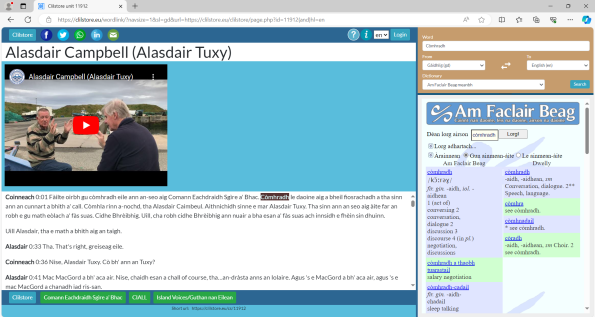
“Fàilte oirbh gu còmhradh eile ann an-seo aig Comann Eachdraidh Sgìre a’ Bhac …”
Alasdair Campbell (Alasdair Tuxy) is interviewed by Coinneach MacÌomhair at Breivig Pier.
And with CIALL assistance, another wordlinked transcript has now been created on the Clilstore platform:
Powered by WPeMatico
Tadhail air Island Voices – Guthan nan Eilean
Powered by WPeMatico
Tadhail air Blog Pàrlamaid na h-Alba
Guest article by Anne Barclay of Golspie. Mòran taing, Anne!
A book and a film: East Sutherland Gaelic Heritage Night featured “Mar a Chunnaic Mise: Nancy Dorian is a’ Ghaidhlig “ – a documentary following linguist Nancy Dorian, who studied the last of the East Sutherland Gaelic speakers. What an interesting evening it turned out to be!
Aileen Ogilvie introduced Professor Neil Simco from the University of the Highlands and Islands, Dornoch Campus, who explained his own interest in the Gaelic language. He is an Englishman who studied Gaelic at Sabhal Mor Ostaig and is fluent in the language albeit with an English accent for which he apologised. He attained his fluency by using the Gaelic language at every opportunity. He told us how there is research going on at present into the crisis within the Gaelic language and the state of Gaelic in the Western Isles. At UHI, they try to make the student experience bilingual, corporate communication is also bilingual, and staff have the opportunity to learn Gaelic. Prof Simco switched easily from Gaelic to English right throughout.
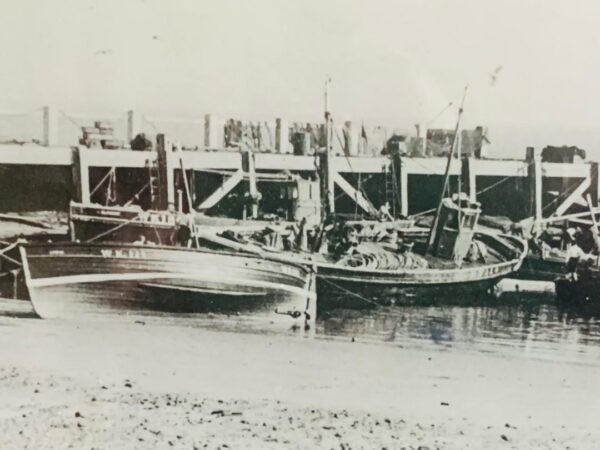
Aileen Ogilvie, herself a Gaelic speaker, introduced the film which had been made some time ago, probably in the 1980’s, and featured Nancy Dorian, a Professor of Linguistics from the eastern seaboard of America who studied the last of the East Sutherland Gaelic speakers. East Sutherland Gaelic was spoken mainly in the fishing communities pf Brora, Golspie and Embo. Of the three villages only Embo was a totally fishing village. Brora’s fishing community was confined to Lower Brora beside the mouth of the river, while in Golspie it was the West End of the village. Gaelic was not spoken in the rest of Brora nor in the East End of Golspie. In the film we saw Nancy Dorian at work in her study in America, checking her pronunciation of Gaelic words over the telephone with the friends she had made in East Sutherland. She wanted to have the authentic East Sutherland accent and spelling of words and this she certainly achieved.
Her friendship with the last Gaelic speakers from East Sutherland lasted throughout their lives and the film is testament to the work she did over many years. Nancy Dorian also wrote a book called “The Tyranny of the Tide” where she documented the oral history of the fishing in East Sutherland, the stories of the people, the local fishing, the role of women in the family, religion, their beliefs and practices. This she wrote down largely in the words of the people she spoke to and lived among from time to time over many years.
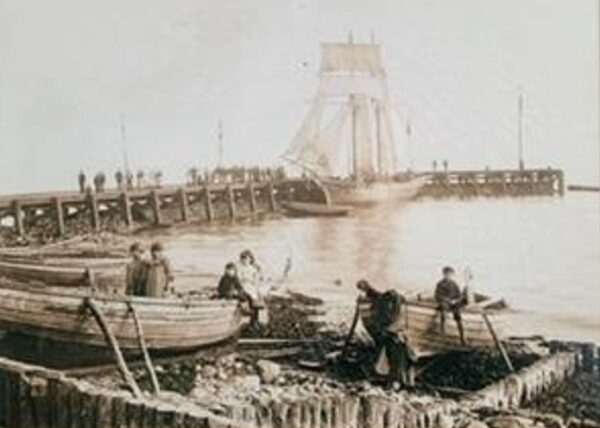
There are numerous examples in the book where the stories are told by the people. One woman talking about her lack of education is quoted here. “I used to get rows Nancy, from the teachers….They thought I should be in school….my mother was very keen to send me when she could….sometimes she would keep my eldest brother off school but it was mostly me. Because I was handier in the house than a boy anyway.” When describing the decision of where to fish on any day, and she is talking about line fishing, it was supposed to be by common agreement, but the young men always deferred to the older men. “ If the older man says, ‘We’ll go here’ they never said yes or no, whether they thought otherwise or not…..they never mentioned it. They always gave “an t-urram do’n aois “(Honour to age).
Nancy Dorian had the ability to insert Gaelic words, still in use when she made her oral history recordings, to great effect throughout the book. “The Tyranny of the Tide” is a book I have read several times in the years I have spent in Golspie and I am always struck by the similarities there are to the Seaboard fishing villages. As in the Seaboard Gaelic has died out but words and phrases remain to remind us of our heritage.
This is a snatch of an old song that Nancy Dorian recorded from the Sutherland family she spent much time with in the 1970’s.
“S iomadh caileag bhoidheach
Eadar Dornach ’s a’ bhail’ seo
‘A do chuuir i treimh brog air
Bu bhoidhich’ na mo chaileagas. “
There’s many a bonny lass Between Dornoch and this village:
There didn’t step a foot (A girl) bonnier than my lass.
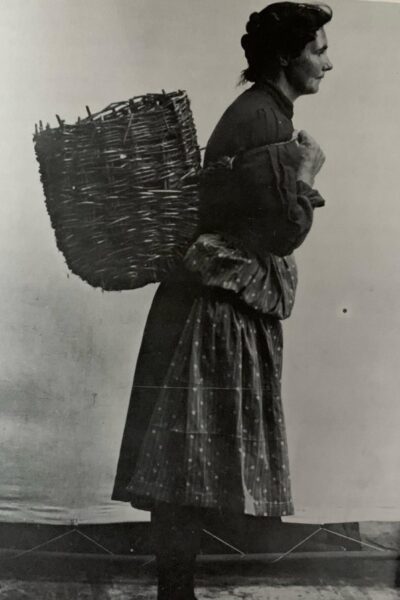

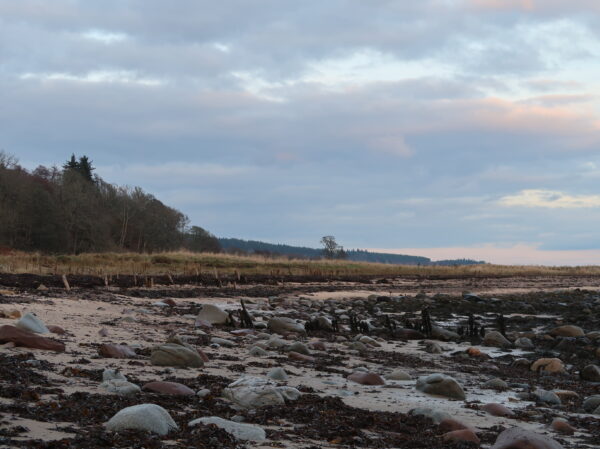
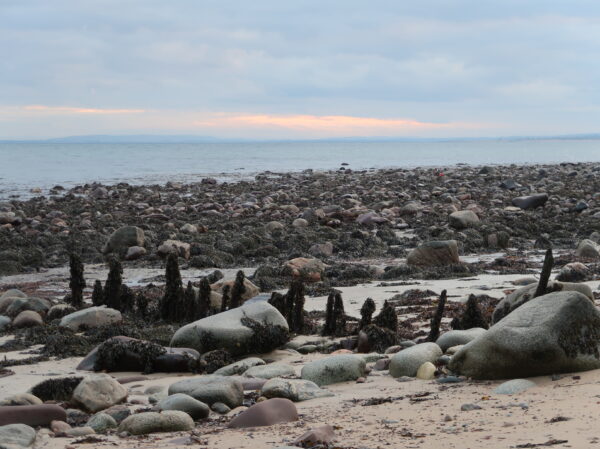
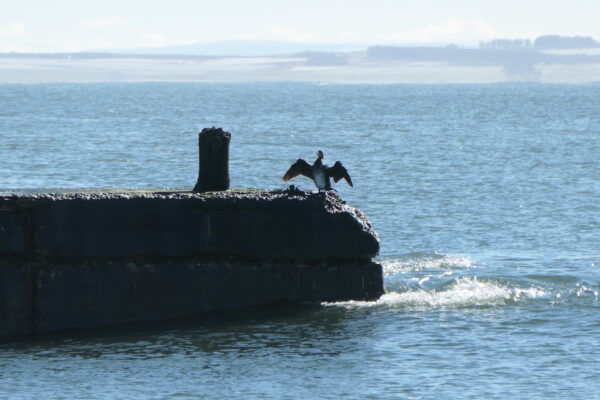
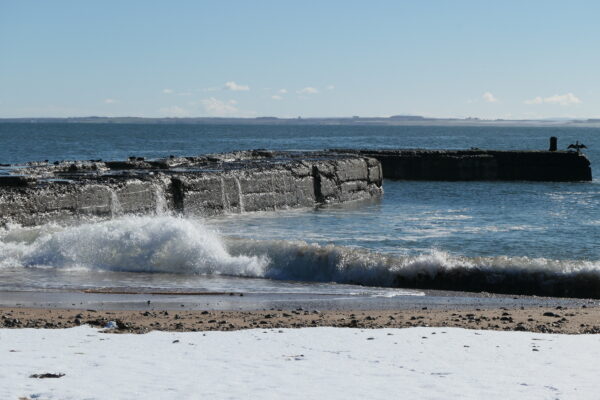
Powered by WPeMatico
Tadhail air seaboardgàidhlig
Le Gordon Wells
Island Voices has created a new playlist on the YouTube video channel for the collection of recordings made about Uist’s taighean-tughaidh – thatched houses. First contributions have come from Tommy MacDonald, telling some of the history from the site of Tobhta Mhic Eachainn and its connection to the “French Macdonalds”, and then quizzing his wife Betty on her memories of being raised in a taigh-tughaidh.
These recordings have been broken up into bite-sized manageable chunks.
In the first two from Tobhta Mhic Eachainn, Tommy presents some stories about Neil MacEachan and his son Alexandre – the “French Macdonalds” – from the remains of Neil’s original house, which was later to be visited by the Duke of Tarentum in an act of filial homecoming following the Napoleonic wars. The video descriptions include links to Clilstore online transcripts for both of these clips, which are also optionally subtitled.
The conversation with Betty comes in four parts. In the first section Betty recalls who built her house (her grandfather), and aspects of her childhood life on the croft, including the herding and milking of the cattle, as well as some of the thatching process as she remembers it.
In the second part Tommy and Betty go on to discuss some of the stiff challenges that would be entailed in keeping a traditional thatched house on a par with modern standards. Talking about the cèilidh culture of earlier times, Tommy recalls how stories would be shared between family members and visitors – some of which remain unexplained to this day.
In the third section Betty and Tommy’s attention turns towards food and drink, and the important place of staples such as eggs and milk – and sometimes rabbit. Services such as electricity and water were a relatively recent introduction. They recall some of the other thatched houses in the area, with a handful having been done up to meet modern standards.
Finally, in the fourth part, Tommy and Betty share memories of more recent times, when a thatched house was converted into a hostel for tourists, under Betty’s mother’s care. In the early days visitors would often stay for weeks, helping out on the croft, and they are fondly remembered. To end, more stories are shared of amusing and perplexing incidents.
Again, Clilstore links are available in the video descriptions, with auto-translatable subtitles an additional option for learners or non-speakers of Gaelic.
The seventh video in the playlist is a longer “omnibus” edition of the Tommy and Betty conversation, which is presented without transcript or subtitles.
With Tommy planning further recordings in the community we can expect more additions to this work in progress in coming weeks, with ongoing CIALL support and in collaboration with the UHI archaeologists based at Cnoc Soilleir.
Powered by WPeMatico
Tadhail air Island Voices – Guthan nan Eilean
Le Gordon Wells
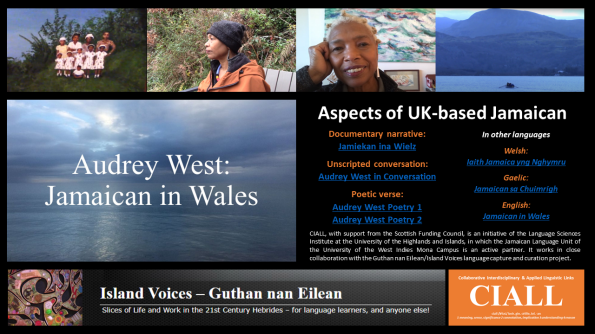 Select any video clip named in this landscape poster, or use the phone-friendly portrait layout.
Select any video clip named in this landscape poster, or use the phone-friendly portrait layout.
Island Voices is extending its “language capture and curation” model, with CIALL support, to new contexts, new genres, and new languages, including the recording of aspects of UK-based Jamaican language use. Gaelic enthusiasts can rest assured this development does not represent a move away from our key linguistic interest in the Outer Hebrides! Far from it, as we engage with other language communities near and far, new opportunities are created for fresh spoken material in video format in Gaelic (and English – and other languages).
We recently filmed Jamaica-born, but London-raised, artist and poet Audrey West at her home in Wales. (Keen followers may well recognise Audrey from her previous contribution to our “Talking Points with Norman Maclean” debates.) We have now created Island Voices-style short video clips in the familiar “documentary” and “interview” formats, while adding a third category of “recitation”, newly added to capture Audrey’s poetry. These films are all listed in the poster above. You can click for either landscape or portrait versions to access live links to any and all of the videos created,
We’re also indebted to Dr Joseph Farquharson from the University of the West Indies Jamaican Language Unit (another Talking Points contributor!), for overseeing the creation of the documentary script in the institutionally approved Cassidy-JLU orthography. Joseph and the JLU team have been extremely busy recently, also providing expert advice to Kingsley Ben-Adir and other cast and production team members for the Bob Marley: One Love biopic. As one commenter(!) put it, this YouTube discussion provides “really interesting insights into how skilled linguistic, particularly phonetic, analysis and description can percolate beyond academia and deliver practical applied impact. Bravo JLU!”
This system has enabled regularised subtitling of the clip on sound linguistic principles. Ironically, as YouTube/Google Translate does not recognise Jamaican as a language, we have paradoxically been forced to label the language used in the Jamaican documentary as “English” in order to be able to add the proper Cassidy-JLU subtitles which underline its separate status! We can confidently predict that the YouTube auto-translate function, which we normally commend, is going to struggle with this!
Our aim in due course, will be to also create a Clilstore transcript incorporating the new Custom Dictionary tool, along similar lines to previous contributions from the Jamaican Language Unit.
We have been demonstrating for some time through “Other Tongues” that the re-purposing in different languages of documentary work in our local community context can be accomplished relatively easily and simply. And we most recently illustrated this at scale with the Children’s Parliament in Barra film. The wider point is that this can be a 2-way street, or perhaps a multi-lane spaghetti junction! With Audrey’s documentary we’ve started with a film made originally in Jamaican and, in a reversal of previous examples, worked up a Gaelic version from it. Not only that, we’ve got Welsh and English versions too!
As hinted in our Duncan Ban MacIntyre piece, “Jamaican in Wales” is just the first of a short series of collections in similar style that explore new fields for Island Voices, including poetic expression, and in “displaced” or “exile” contexts. This is work in progress, with more to come from other island geographies.
Di stuori stil a gwaan. Jos laik Bob Marley se, “Wi faawad in dis jenarieshun chrayomfantli!”
Powered by WPeMatico
Tadhail air Island Voices – Guthan nan Eilean
Le Gordon Wells
Kenny Murdo (Rev Ferguson) and his sister Christine are in conversation with Coinneach MacÌomhair in this video from Comann Eachdraidh Sgìre a’ Bhac, with memories of Sràid a’ Bhac, Bùth Bellann and their careers. This “Clilstore treatment” provides an online wordlinked transcript with the video embedded. You can get a translation of any word you don’t know by clicking on it: https://clilstore.eu/cs/11883
Tadhail air Island Voices – Guthan nan Eilean
Powered by WPeMatico
Tha mi gu math dèidheil air a’ chòmhlan roc Big Audio Dynamite a stèidhich Mick Jones ann am meadhan nan 1980an às dèidh dha an Clash fhàgail. Ged a tha mi air leth dèidheil air a’ Chlash, bha mi ro òg a bhith ag èisteachd riutha fhad ’s a bha iad fhathast còmhla.
Ach nuair a bha mi nam dheugaire aig deireadh nan 1980an bha B.A.D còmhla agus a’ cur a-mach deagh cheòl. Bha na clàran singilte mòra agam – E=MC2 agus V13 agus C’ Mon every Beatbox. Cheannaich mi an treas LP aca Tighten Up Vol 88 nuair a thàinig e a-mach agus abair gur e clasaig a bh’ ann. Chòrd e rium mar a bhiodh iad a’ measgachadh diofar ghnèithean ciùil – reggae, punc is roc is eile le giotàr binn brèagha Mick Jones. B’ iad a’ chiad chòmhlan a chleachd sampailean cuideachd. Bhiodh iad a’ seinn mu rudan cudromach cuideachd – a’ moladh ioma-chultarachd is a’ cur an aghaidh gràin-cinnidh is mar sin air adhart. Agus sgrìobh Joe Strummer cuid de na h-òrain còmhla ri Mick – is mar sin, ’s e òrain a’ Chlash a bh’ annta gu ìre!

B.A.D ann an 2011: clì-deas: Greg Roberts, Don Letts, Mick Jones, Leo E-zee Kill Williams, Dan Donovan
Ged is e meatailt, punc agus prog as motha a tha a’ còrdadh rium, tha mi air leth deidheil air Big Audio Dynamite agus fhuair mi cothrom am faicinn beò ann an 2011 nuair a thàinig iad air ais còmhla airson turas. B’ e an t-aon gearan a bh’ agam air ais sna 1980an gun robh an ceòl aca air a chlàradh ann an dòigh caran ro 1980s – ach ann an 2011 chluich iad a h-uile rud le giotàr trom agus bha an ceòl dìreach mar a bu choir dhaibh a bhith air a chlàradh sa chiad dol a-mach!
Ach ‘s e an rud mu Big Audio Dynamite gu bheil iad underrated. Chan eil gu leòr daoine air an cluinntinn no a’ tuigsinn dè cho cudromach ‘s a tha iad. Agus bho chunnaic mi beò iad ann an 2011, tha e air a bhith na mhisean dhomh daoine iompachadh gu ceòl B.A.D.
Seo iad a’ cluich Beyond the Pale ann an Glaschu – sàr òran mu ioma-chultarachd agus eilthireachd!
Bha mi ag èisteachd ri B.A.D air an turas agam air Loidhne a’ Chinn a Tuath bho chionn ghoirid agus smaoinich aig an àm gur bheil an loidhne agus an còmhlan gu math coltach ri chèile.
Tha mi den bheachd gum bu choir a h-uile duine èisteachd ri Big Audio Dynamite co-dhiù aon turas nam beatha agus tha mi fada den bheachd cuideachd gum bu choir a h-uile duine an Alba a dhol air loidhne na Gàidhealtachd a Tuath co-dhiù aon turas nam beatha. Coltach ri B.A.D cuideachd, cha d’ fhuair an loidhne riamh an cliù air a bheil e airidh.
Tha a h-uile duine eòlach air Loidhne na Gàidhealtachd an Iar eadar Glaschu, an t-Òban, an Gearasdan is Malaig, loidhne a tha daonnan a’ buannachadh dhuaisean leis cho brèagha sa tha e le beanntan, lochan, mòinteach agus drochaid Harry Potter. Tha Loidhne a’ Chaol gu math ainmeil cuideachd. Ma chumas mi orm leis a’ mheatafor, is e an Clash a th’ anns an Loidhne na Gàidhealtachd an Iar agus stuth solo aig Joe Strummer a th’ ann an Loidhne a’ Chaoil!
Le Loidhne a’ Chinn a Tuath, ‘s e coimiutairean gu Inbhir Nis as motha a tha a’ cleachdadh taobh deas na loidhne, agus chan eil gu leòr daoine a’ cleachdadh taobh tuath na loidhne idir. Chan eil fhios aig a’ mhòr-chuid de luchd-turais gu bheil e fiù’ s ann agus ‘s e glè bheag de dh’Albannaich a tha air cluinntinn mun loidhne nas motha.

Georgemas – an ceann-rèile as fhaide a tuath ann an Alba – Inbhir Theòrsa gu tuath agus Inbhir Ùige dhan ear
Chithear an diofar eadar na trì loidhnichean mòra Gàidhealach bho fhigearan an luchd-cleachdaidh:
| Stèisean | Àireamh Luchd-siubhail (2022/23) |
| An t-Òban | 186,000 |
| An Gearasdan | 146,000 |
| Malaig | 71,692 |
| Caol Loch AIllse | 46,634 |
| Inbhir Theòrsa | 31,446 |
| Inbhir Ùige | 14,924 |
Chanadh cuid gu bheil an loidhne a’ toirt ro fhada is gu bheil e a’ toirt nas fhaide na an rathad ma tha thu a’ dol fad na slighe gu Gallaibh, ach cha bhi sin a’ cur bacadh air daoine bho bhith a’ dol air loidhne na Gàidhealtachd an Iar far a bheil an aon rud fìor.
Tha an loidhne fada ceart gu leòr – 161 mìle agus 4.5 uairean a thìde eadar Inbhir Nis agus Inbhir Ùige ach tha an turas eadar Glaschu is Malaig gu math fada cuideachd – 5 uair a thìde agus 162 mìle a dh’fhaid.
‘S e an fhìrinn a th’ ann gur e loidhne anabarrach brèagha a th’ innte agus gum biodh i air gach sanas TBh is catalog aig VisitScotland mur a robh loidhne na Gàidhealtachd an Iar againn mar-thà. Chanainn gu bheil i nas fheàrr na loidhne sam bith ann an Sasainn no sa Chuimrigh mar eisimpleir – ged a tha an Settle and Carlisle agus an Cambrian Coast aca.
Tha a h-uile rud aig Loidhne a’ Chinn a Tuath – bailtean snoga ri taobh na mara, An Caol Catach, na Flobhaichean (the flow country) agus tòrr a bharrachd. Tha na seallaidhean gu math Gàidhealach ach caran eadar-dhealaichte ri taobh siar a Gàidhealtachd oir tha na beanntan agus na seallaidhean eile a chithear nas coltaiche ris a’ Chuimrigh no ri Èirinn. Tha a’ phàirt mu dheireadh den loidhne a-staigh dhan tìr agus air falbh bhon rathad agus tha na Flobhaichean dìreach air leth. Cho còmhnard, cho lom agus cho eadar-dhealaichte ri rathad-iarainn sam bith eile.
Agus nuair a ruigeas tu ceann na loidhne, tha Taigh Iain Ghròt, Rubha Dhunait (an t-àite as fhaide a tuath air tìr mòr na h-Alba), Arcaibh agus tòrr a bharrachd.
Ach na gabh ris an rud a thuirt mi – rach air loidhne a’ Chinn a Tuath! Agus èist ri B.A.D!
San dealachadh, ’s e rud eile mu B.A.D gu bheil iad a’ sìor bhrosnachadh ioma-chultarachd – a’ measgachadh ceòl Shasainn, Ameireagaidh agus Iameuga. Tha Gallaibh caran mar sin – a’ toirt còmhla cultar ioma-chànanach na Gàidhlig, na Lochlannais agus na Scots!
Alasdair
Tadhail air Trèanaichean, tramaichean is tràilidhean
Powered by WPeMatico